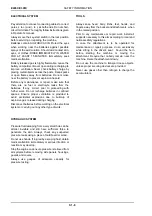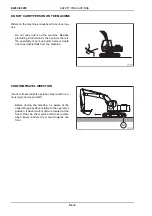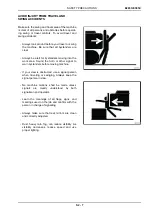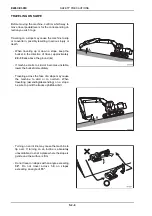
E265C-E305C
SAFETY INFORMATION
S1 - 2
OPERATING
Do not run the engine in closed buildings without
proper ventilation capable to remove harmful exhaust
gases which concentrate in the air.
Keep the operator’s compartment free of foreign
objects, especially if not firmly secured. Never use
the machine to transport objects, unless proper
securing points are provided.
Do not carry riders on the machine. Study and
familiarise with escape routes alternative to normal
exit routes. For your personal safety, do not climb on
or off the machine while it is in motion.
Make sure that bystanders are clear of the machine
operating range before starting the engine and
operating the attachment. Sound the horn.
Obey all hand signals, safety indications and signs.
When backing, always look to where the machine is
to be moved.
Be alert of the position of bystanders. Should
someone enter the work area, stop the machine.
Maintain a safe distance from other machines or
obstacles to ensure required visibility conditions.
Always give way to loaded machines.
Maintain a clear vision of the surroundings of the
travel or work area at all times. Keep cab windows
clean and repaired.
When pulling loads or towing through a cable or
chain, do not start suddenly at full throttle. Take-up
slack carefully. Avoid kinking or twisting chains or
cables.
Carefully inspect the towing items for flaws or
problems before proceeding. Do not pull through a
kinked chain or cable as the high anomalous stresses
existing in this condition may induce failures in the
kinked portion.
Always wear heavy gloves when handling chains or
cables.
Chains and cables should be securely anchored
using suitable hooks. Anchor points should be strong
enough to withstand the expected load.
Keep anyone clear of anchor points and cables or
chains.
Do not pull or tow unless the operator’s
compartments of the machines involved are properly
protected against possible backlash in case of cable
or chain failure or detachment.
Be alert of soft ground conditions close to newly
constructed walls. The fill material and machine
weight may cause the wall to collapse under the
machine.
In darkness, check area of operation carefully before
moving in with the machine. Use all lights provided.
Do not move into low visibility areas.
If the engine tends to slow down and stall for
whatever reason under load or at idle, immediately
report this problem to the maintenance managers for
proper action.
Do not operate the machine until this condition is
corrected. Regularly check all exhaust system
components, as exhaust fumes are toxic for the
operator.
Operators must know the performance of the
machine they are driving. When working on slopes or
near sudden level drops in the terrain, pay attention
not to lose adherence and avoid loose soft ground
since overturn or loss of machine control could result.
If noise level is high and exceeds 90 dB (A) over 8
hours at the operator’s ear, wear approved ear
protection in compliance with local regulations.
Do not operate the machine if you are extremely tired
or feel ill. Be especially careful towards the end of the
working shift.
Where removable counterweights are provided, do
not operate the machine if they have been removed.
When operating the machine, keep in mind height
limits of overhead doors, arches, overhead cables
and lines as well as width limits of corridors, roads
and narrow passages.
Also, get to know load limits of the ground and
paving type of the ramps you are to work on.
Beware of fog, smoke or dust that obscure visibility.
Always inspect the working area to identify potential
risks such as: inclines, overhangs, trees, demolition
rubble, fires, ravines, steep slopes, rough terrain,
ditches, crowns, ridge trenches,diggings in traffic
areas, crowded parking lots, crowded service areas,
fenced zones. In such conditions, proceed with
extreme care.
Whenever possible, avoid crossing over obstacles
such as very rough terrain, rocks, logs, steps,
ditches, railroad tracks.
When obstructions must be crossed, do so with
extreme care and at a square angle, if possible. Slow
down.
Ease up to the break-over point, pass the balance
point slowly and ease down the other side also using
the attachment, if necessary.
To overcome deep trenches or sinking ground, place
the machine perpendicular to the obstacle, drastically
reduce ground speed and start crossing using also
the attachment if necessary, only after assessing that
ground conditions allow the traverse safely and
without risks.
The gradient you may attempt to overcome is limited
by factors such as ground conditions, load being
handled, machine type and speed, and visibility.
There is no substitute for good judgement and
experience when working on slopes.
Avoid operating the attachment too close to an
overhang or high wall, either above or below the
machine. Beware of caving edges, falling objects
and landslides. Remember that such hazards are
































